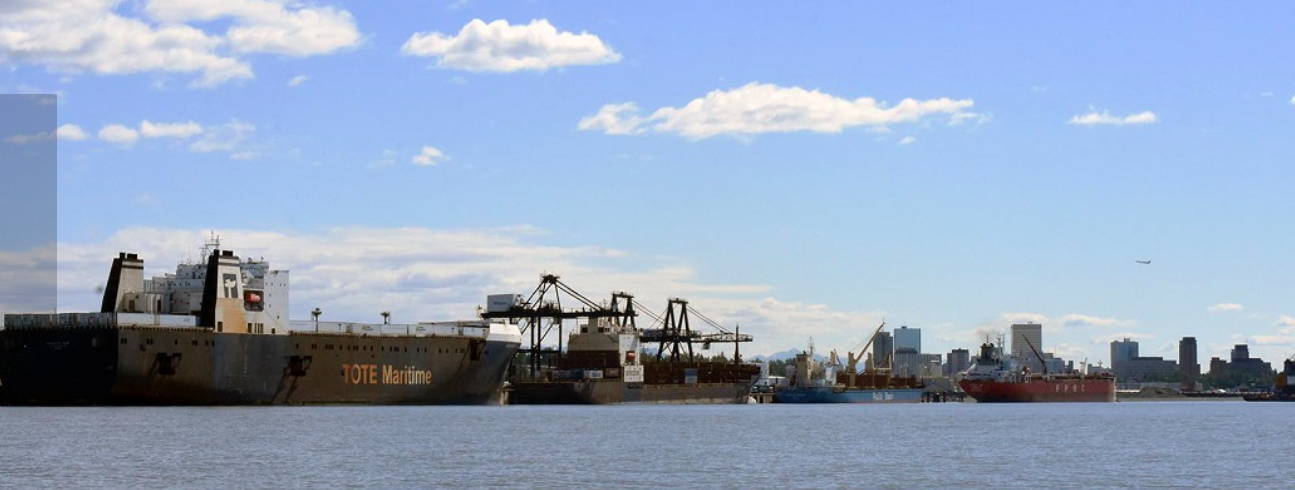Sen. Dan Sullivan today announced the U.S. Department of Transportation has awarded the Port of Alaska a $20 million grant for infrastructure. It’s a patch for a project that has eaten up hundreds of millions of dollars in the past decade to get ahead of failing docks and pilings.
Since September, the port has received $45 million in federal grants to upgrade its aging infrastructure and help pay for a new fuel and cement terminal, Sullivan’s office said.
Sullivan noted that the port, where fuel, food, and construction materials arrives for most of Alaska, is in dire straits due to its corroding supports. About 2,400 shipping containers are unloaded at the port each week. Built in the late 1950s, the docks are reaching the end of their lifespan and have been patched together to withstand tides, salt corrosion, and earthquakes. The port is undertaking a modernization project to upgrade the infrastructure, which will also allow for deeper-draft cargo ships.
“I want to thank Secretary Chao for recognizing the dire state of one of Alaska’s most important pieces of infrastructure and heeding the call of Alaskans by approving this much-needed PIDP grant,” said Sen. Sullivan. “The Port of Alaska not only serves the most basic needs of a broad swath of Alaskans – including fuel, food, construction materials, and other goods – but also America’s security interests as an Arctic nation. The Port of Alaska is the only Department of Defense strategic seaport near the Arctic—a fact we cannot overlook as sea ice recedes, traffic accelerates and our country’s adversaries, particularly Russia, grow their maritime capabilities in the region. This grant will help restore the Port of Alaska’s status as a safe, cost-effective, reliable and resilient piece of infrastructure.”
Sullivan brought Secretary of Transportation Elaine Chao to Alaska to meet with Port Director Stephen Ribuffo in 2017. Since taking office, Sullivan has made the port a priority of his office, convening agency leaders over the past four years to educate them about the strategic nature of the port, as well as its importance to the state economy as a whole.
A port expansion that has spent more than $300 million ground to a halt in 2010 after it was discovered that the port pilings were seriously damaged and their load-bearing capacity was compromised. The port has been spending millions of dollars each year to surround the old pilings with new metal jackets, but those, too, have a limited lifespan, and only half of the pilings have been encased.
The overall cost of bringing the decrepit port up to grade could be $2 billion, according to a contractor’s estimate in 2018.
TARIFFS UP FOR FUEL, CEMENT
The Municipality of Anchorage in 2019 approved tariff increases on commodities coming through the port. Those tariffs were implemented Jan. 1, 2020. On fuel, the tariff will rise up between 4 and 5 cents every year through 2029, when the tariff will be 56.3 cents per barrel. Cement will also rise to reach $5.72 cents per ton by 2029.
The tariff increase is earmarked to pay for a $200 million petroleum and cement terminal.

The real crime here is mayor Sullivan couldn’t account for the 1st $300 million that was supposed to fix the port because after it was finished it was a total failure and then he said we need to pump another $400 million in it to fix it. The 1st $300 million that was taken from taxpayers and some grants has never been fully accounted for. Corrupt city politicians and contract kickbacks are a key signature in Anchorage, Alaska.
Yes and this is why politicians should not get any more money. No new taxes, no new fees. They will steal us blind and they will be rich.
Well, actually it’s an argument for putting good people in office instead of nitwits. Or con men.
Given the magnitude of the problems at the port, the $20 million will likely be used to update the security shack that prevents the public from even seeing the port. Kinda hard to get excited about a facility you cannot look at. Just a thought.
Once again the feds come to the rescue and bail out the unsustainable Alaskan economy, but at $ 1 Trillion a year “in the red” the federal budget deficit is completely unsustainable itself?
Not sure that $20 million is going to have the impact you have in mind. If you want a project of that magnitude, Boston’s “Big Dig” would work. It cost billions, mostly federal, and kept organized labor employed for decades in the People’s Republic of Massachusetts.